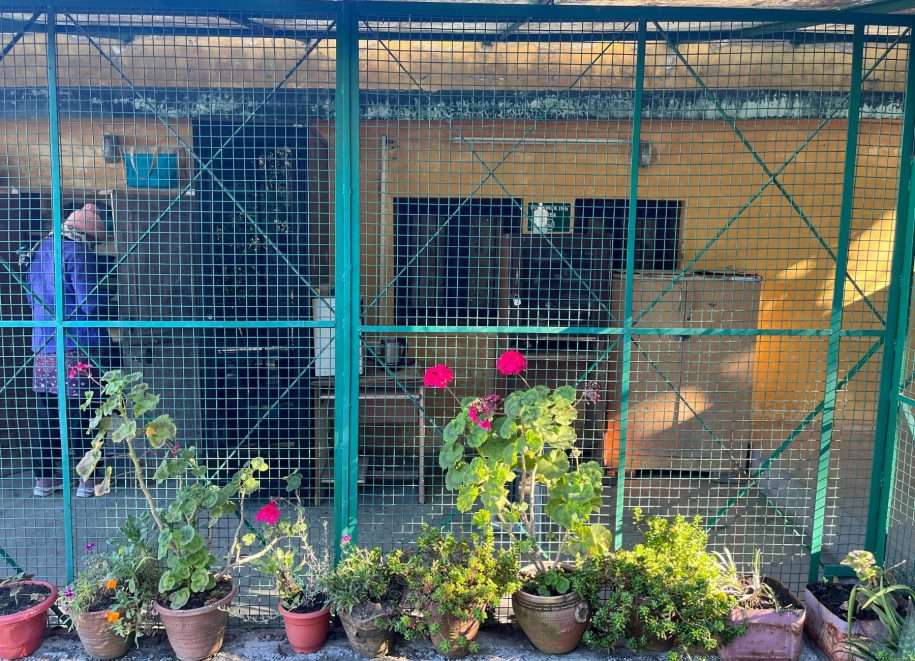“I was not allowed outside of my home, so I did not know about any job opportunities.”
Kavita* — Orakhan Village, Uttarakhand
Kavita* speaks softly as her daughter falls asleep on a bed next to us. It is a sunny winter afternoon, and she is on her lunch break. We are in the guest house attached to her workplace of 14 years, up high in the mountainous village of Orakhan.
“The women in my family don’t usually go to college, but I insisted and fought with my grandfather to go.” Despite this, she knew that she would once again be consigned to her home after her studies. Then B2R Technologies brought business process outsourcing and jobs to this remote mountain town nestled in the Himalayas. Members from the associated Chirag NGO came to her house and persuaded her brother to let her apply for a job, and thus began a career which she never anticipated, where she worked in legal and accounting departments, became skilled in several roles and gained financial independence and mobility. She is one of many women who were enabled by this opportunity to join the formal workforce within their own village.
A 2022 International Labour Organization report on decent work deficits among rural workers highlighted the precarious working conditions of female workers, usually employed in the informal economy with low-paying and low-skilled jobs compared to their male counterparts. A 2015 recommendation ‘Transition from the Informal to the Formal Economy Recommendation’ also emphasized the need to take urgent and appropriate measures to enable the transition of workers from the informal to the formal economy.
Such a shift can be aided, in part, by the decentralisation of knowledge work away from urban centers to remote areas of the country. I visited an enterprise like this in December 2022, in the hilly district of Nainital in Uttarakhand, where a company called B2R Technologies has set up a BPO unit with about 50 employees. These employees are scattered along the villages from the surrounding area, travelling through woodland-blanketed mountains on both foot and bus to reach their workplace.
The company undertakes outsourced assignments, with different departments for functions such as legal research, accounting, etc. It hires employees coming from varying educational backgrounds, ranging from matriculation to graduation, and trains them for 4-6 weeks in-person, using a variety of interactive encouragement methods, like the ‘five-star’ system where trainees earn stars for completing new tasks and get ‘five-star’ chocolate upon collecting five of them.
This office and its employees face some unique challenges, such as the long commute to work, a large part of which needs to be done on foot. The employees who avail the use of public transport are limited to two buses a day and are sometimes compelled to hitchhike to work if they miss the bus. The company has made an effort to tackle this problem in various ways— a small guesthouse with two rooms and a kitchen next to the office is available to employees who miss their bus after the shift concludes. They have also integrated remote work into their workplace post-pandemic, by providing the employees with laptops and a network connection through their phones. This has removed the commute altogether for the employees with the longest distance to travel.
Introducing remote work has also provided opportunities for women with very young children, who can begin working online after their maternity leave. The aforementioned guest house facility also enables women who have school-going children to drop their children to a nearby NGO school on the way to work, then pick up the children and have them spend the remainder of the work shift resting or playing in a safe environment. Due to these enabling factors, the office has a majority of female employees.
A long-term employee at this BPO explains how, when applying for a job at the company fourteen years ago, she faced disapproval from her family and community. The local NGO Chirag, actively involved in this area, encouraged her to apply and convince her family members to see the upsides of this work. Now, after years of gradual hiring of female employees by B2R Technologies, such interventions are no longer needed. The idea of women seeking employment outside the house has gradually taken root in most of the community, giving women a certain degree of financial independence. A younger employee that I spoke with, told me about how she bought a scooter with her own income, and how it allows her to travel alone and meet her friends. The employees also explain how this normalisation of formal work has led to an increase in the average age of marriage for women in the community – from getting married at 20 a decade ago to now waiting till they are at least 35 years old.
However, such formalized work cannot address structural inequalities such as the disproportionate care burden borne by women. For instance, women working in this office are still expected to manage the double burden of work and care responsibilities – they complete their housework before coming to work, rising early to clean the house and prepare meals. While some report receiving help from their spouses in domestic tasks, most men are largely unburdened by the responsibility of managing their homes. In fact, most women seek support from other women, such as their mothers or other female family members, to take on childcare duties while they are at work. If they work online, they are expected to balance work and household responsibilities with ease, preparing meals and being available to their children. Many female employees with whom I spoke said that they preferred working from office, despite the arduous journey, because it is easier to comply with one set of expectations rather than having to juggle between the two.
The challenges women face, especially in remote areas, are numerous and cannot have a single bullet solution. However, efforts made by firms like B2R Technologies and NGOs like Chirag, which entrench themselves in the community that they work with and listen to the needs of their employees, are crucial. Formal work outside of the home allows women greater agency and resources to make their own decisions and is a first step towards empowering them to tackle the challenges that they face.
As a young female employee here told me, “It is a system of trust. It can work from home and can work with this hybrid model.”
*The respondent’s name has been changed to protect her privacy.
About the Author
Kaavyayani Pal is a Research Associate with the Small, Growing Businesses and Employment vertical at LEAD. She is passionate about developmental economics and the application of data science in improving public policy. Kaavyayani hopes to use her research in understanding the socioeconomic structures in India.





